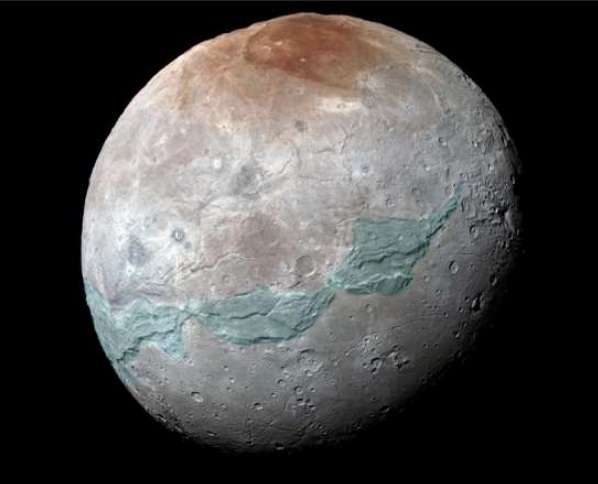March 22, 2016 report
Researchers study Charon's internal evolution

(Phys.org)—Even though NASA's New Horizons mission provided invaluable information about Pluto's moon Charon and delivered detailed images of this unique and interesting rocky body, many mysteries still lie unresolved beneath its frigid surface. Recently, a team of scientists from the Israel Institute of Technology in Haifa, Israel and the University of California, Los Angeles (UCLA), sought to solve one of Charon's secrets by creating a model that explains its internal evolution. The study was published in a Mar. 4 paper available on arXiv.org.
New Horizons completed the first close flyby of the Pluto-Charon system on July 15, 2015. The spacecraft obtained high quality images of Charon's surface, identifying a series of perplexing and distinctive features. Among the most striking features observed are a series of canyons that cover the moon's surface in the region near its equator. These canyons have various sizes, cutting across and around other intriguing surface features.
Some of these features are actually higher than the surrounding environment. Together, these conjoin to form what we have termed the 'tectonic belt', a collection of canyons, ridges and scarps, forming a great circle around Charon.
"In some places, the features strongly indicate that the surface of Charon has been pulled apart. If Charon has undergone a period of expansion, it is possible that its surface stretched, giving rise to these kinds of features," Uri Malamud of the Israel Institute of Technology in Haifa, told Phys.org.
According to the paper published by Malamud and his colleagues, Charon experienced two contraction-expansion episodes in its history that may provide the proper environment for the formation of the tectonic belt.
They argue that the first episode must have happened within the first few hundred million years after Charon's formation, resulting in size changes that are sufficiently large to explain not only the extensional environment that could give rise to features like serenity chasma, but also other surface features along the tectonic belt that require a compressional environment.
The model proposed by the authors considers several processes that change the internal structure of Charon as its evolution progresses.
"We make the most basic assumption that Charon formed cold and undifferentiated, with a homogenous structure of mixed ice and rocks. We also consider, based on various related experimental studies, that Charon has residual porosity after its formation," Malamud said.
The most massive objects naturally have the greatest pressure, and are therefore less likely to contain porosity. But Charon happens to belong to a class of intermediate-sized objects that are rather massive, but not enough to completely eliminate porosity.
The scientists also emphasized that any object that is composed of rocky material also contains long-lived radioactive nuclides that release radiogenic heat over hundreds of millions of years.
"In Charon, this heat builds up, causing the initially cold internal ice to warm up. Warm ice is more susceptible to compaction, and therefore Charon compresses and decreases in size," the researchers noted.
However, there may be a different alternative to explain Charon's surface features. A cold initial state could be consistent with all three formation scenarios currently proposed in the scientific literature for Charon; even the in-situ formation scenario of Charon and Pluto (the hypothesis that Pluto and Charon formed in place as a pair) could fit observations. The other two formation scenarios are that Charon was captured by Pluto or that Charon formed as a result of a giant impact into Pluto (currently the favored hypothesis).
"Our work therefore adds to the formation literature by pointing out that all options are definitely plausible, and that further studies are required," Malamud concluded.
More information: The Contraction/Expansion History of Charon with implication for its Planetary Scale Tectonic Belt, arXiv:1603.00875 [astro-ph.EP] arxiv.org/abs/1603.00875
Abstract
The New-Horizons mission to the Kuiper Belt has recently revealed intriguing features on the surface of Charon, including a network of chasmata, cutting across or around a series of high topography features, conjoining to form a belt. It is proposed that this tectonic belt is a consequence of contraction/expansion episodes in the moon's evolution associated particularly with compaction, differentiation and geophysical reactions of the interior. The proposed scenario involves no need for solidification of a vast subsurface ocean and/or a warm initial state. This scenario is based on a new, detailed thermo-physical evolution model of Charon that includes multiple processes. According to the model, Charon experiences two contraction/expansion episodes in its history that may provide the proper environment for the formation of the tectonic belt. This outcome remains qualitatively the same even if we assume a different initial composition and mass. Two alternative explanations for the precise localization and orientation of Charon's tectonic belt are speculated.
© 2016 Phys.org





















